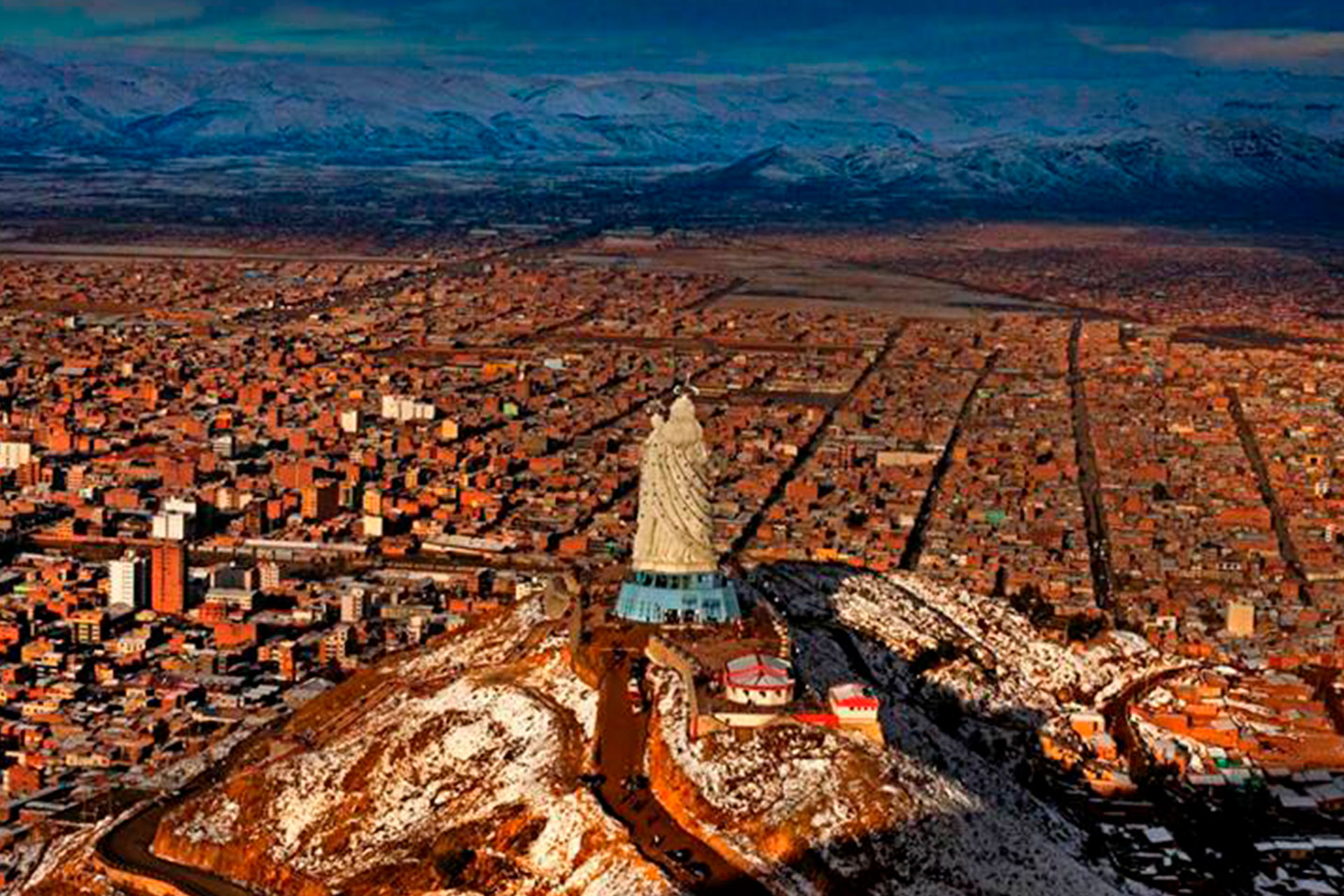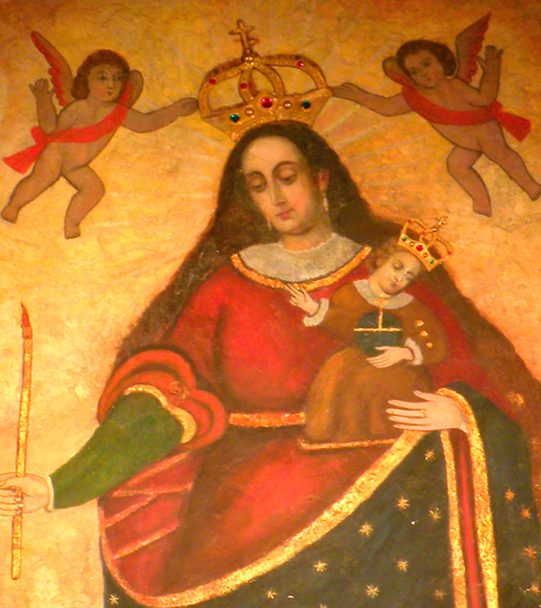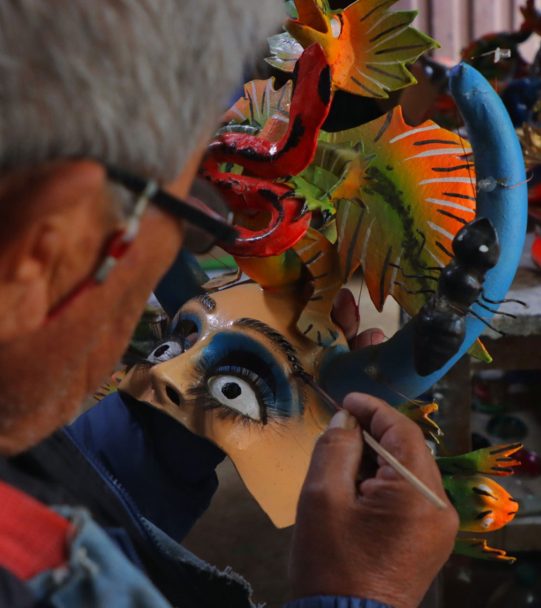Oruro
Discover the department of Oruro, a land of Andean contrasts where mining history, living culture and breathtaking landscapes captivate from the first moment. Its capital city, Oruro, is known for its famous Carnival, declared a World Heritage Site. Here you will also find the Sajama National Park, home to the highest snow-capped mountain in Bolivia and unique natural scenery for ecotourism. Oruro invites you to immerse yourself in an authentic experience, among ancestral traditions, religious art and unforgettable high altitude landscapes.
Connectivity
You can reach Oruro by road by private vehicle or by bus, from the main cities of the country, such as La Paz, Cochabamba y Potosi, The trip is made through paved roads that connect directly with the capital of the department. The overland trip varies between 3 and 8 hours, depending on the point of departure. In addition, the Juan Mendoza Airport, located a few kilometers from downtown Oruro, offers regular flights from La Paz, Santa Cruz and other cities, facilitating quick and convenient arrival for visitors.
Oruro
Subscribe to receive news about Caminos Andinos
Temperature
Average 11 to 20°C In Sajama National Park, the climate is cold and dry, with temperatures ranging between 5°C and 10°C.
Weather
Tempering
More destinations
Activities and attractions
Oruro offers you an endless number of unforgettable experiences. Visit its fascinating museums, such as the Eduardo López Rivas and the Casa de la Cultura Simón I. Patiño, and discover the local history and art. Visit the Sanctuary of the Virgen del Socavón, a site full of devotion and tradition. Explore the Sajama National Park, with its imposing landscapes and adventure activities. Enjoy the typical gastronomy, such as the charquekán and immerse yourself in the living culture of its ancestral communities. Oruro is waiting to offer you a trip full of history, nature and tradition.
Carnival of Oruro - Rotcivrosas
PHOTO: Vice-Ministry of Tourism Bolivia
Oruro Carnival
PHOTO: Vice-Ministry of Tourism Bolivia
Community - Sajama
PHOTO: Vice-Ministry of Tourism Bolivia
Hot Springs - Sajama
PHOTO: Vice-Ministry of Tourism Bolivia
Discover what we do
-
-
CULTURE
Museums and culture:
Discover Oruro through its museums, where history, culture and identity come alive. The Eduardo López Rivas Anthropological Museum holds pre-Columbian pieces that reveal the cultural roots of the region. The Simón I. Patiño offers art and heritage exhibits that showcase local talent and the heritage of this philanthropist from Oruro. The Mineralogical and Geological Museum surprises with a unique collection of minerals, fossils and precious stones that reflect the natural wealth of the altiplano. The San Miguel de la Ranchería Museum of Sacred Art houses valuable colonial religious works, including mestizo baroque altarpieces. The Machacamarca Railway Museum exhibits historic locomotives, reflecting the rich railway and mining heritage of the region. Bolivia.
Virgen del Socavón Sanctuary
The Sanctuary of the Virgen del Socavón is the spiritual and cultural heart of Oruro. Its altar covered with gold leaf enhances the image of the patron saint of the Oruro Carnival, recognized as the most important of the World Heritage Site. This temple not only represents the faith of thousands of devotees, but also a unique fusion between Andean tradition and Catholic religiosity.
Sajama National Park and the cultural connection
Discover in Sajama National Park, the imposing pre-Hispanic chullpas of Pumiri, funerary towers that show the ancestral architecture. Also, marvel at the rock art in sites such as Pultuma and Pumiri, stone engravings that tell scenes of Andean life and cosmovision. This destination connects you with the living history of the Andes, surrounded by a stunning natural landscape.
-
-
NATURE
Lagos:
The Uru Uru and Poopó lakes are key to Oruro's ecosystem. Uru Uru is attractive for its Andean birds, ideal for wildlife watchers. In the Poopó, when there is water, you can go boating and fishing. In the dry season, the lake reveals a saline plain perfect for guided hikes. Both offer unique experiences that connect the visitor with the nature altiplanic.
Sajama National Park
Sajama National Park invites you to discover its main treasure, the majestic Tata Sajama, the highest peak in the world. Bolivia. With its breathtaking landscapes, you can enjoy activities such as trekking, hiking and observation of flora and fauna, such as Andean condors and vicuñas. In addition, its geysers and natural hot springs, along with the Queñua forests, make this a unique destination for adventure tourism and connection with nature.
-
-
ANCESTRAL COMMUNITIES AND RURALITY
Indigenous communities and peoples:
Oruro is home to several ancestral communities that keep their traditions and customs alive. The Aimaras and Quechuas, among other native peoples such as the Urus, Uru Muratos and Uru Chipayas, offer visitors the opportunity to learn about their rich cultural heritage through their dances, textiles and ceremonies. The Aimaras, for example, celebrate the «Andean New Year» with rituals dedicated to Pachamama, while the Quechuas continue to transmit millenary knowledge through their weavings and traditional architecture.
Carnival of Oruro: Fairs and festivities of ancestral origin
The Carnival of Oruro, declared World Heritage Site, The festival, which takes place between February and March, is famous for its impressive parade of dances, such as the Diablada, and for its elaborate and colorful costumes. This festival, centered on the devotion to the Virgen del Socavón, offers you a deep connection with ancestral traditions, an explosion of music and dances, and the opportunity to experience one of the most spectacular festivals in the region.
-
-
GATRONOMY
The gastronomy of Oruro is a true feast for the senses, you can not miss the charquekán, a delicious stew of dried meat and potatoes. The roasted face, a unique recipe that highlights the lamb meat at its best, and the api, a sweet and comforting drink made from purple corn. These and other dishes full of history and flavor will allow you to explore the essence of Oruro in every bite.
-
-
CRAFTS
The Carnival of Oruro is a real engine for the production of handicrafts, especially in sheep, llama and alpaca wool. From colorful masks to vibrant fabrics, each piece reflects the tradition and festive spirit of the region. In Sajama, artisans follow ancient techniques to create unique garments, imbued with the beauty and mysticism of the area. You cannot miss a visit to the workshops in Tomarapi, where you will take with you an unforgettable souvenir of this fascinating experience.
CULTURE
Museums and culture:
Discover Oruro through its museums, where history, culture and identity come alive. The Eduardo López Rivas Anthropological Museum holds pre-Columbian pieces that reveal the cultural roots of the region. The Simón I. Patiño offers art and heritage exhibits that showcase local talent and the heritage of this philanthropist from Oruro. The Mineralogical and Geological Museum surprises with a unique collection of minerals, fossils and precious stones that reflect the natural wealth of the altiplano. The San Miguel de la Ranchería Museum of Sacred Art houses valuable colonial religious works, including mestizo baroque altarpieces. The Machacamarca Railway Museum exhibits historic locomotives, reflecting the rich railway and mining heritage of the region. Bolivia.
Virgen del Socavón Sanctuary
The Sanctuary of the Virgen del Socavón is the spiritual and cultural heart of Oruro. Its altar covered with gold leaf enhances the image of the patron saint of the Oruro Carnival, recognized as the most important of the World Heritage Site. This temple not only represents the faith of thousands of devotees, but also a unique fusion between Andean tradition and Catholic religiosity.
Sajama National Park and the cultural connection
Discover in Sajama National Park, the imposing pre-Hispanic chullpas of Pumiri, funerary towers that show the ancestral architecture. Also, marvel at the rock art in sites such as Pultuma and Pumiri, stone engravings that tell scenes of Andean life and cosmovision. This destination connects you with the living history of the Andes, surrounded by a stunning natural landscape.
NATURE
Lagos:
The Uru Uru and Poopó lakes are key to Oruro's ecosystem. Uru Uru is attractive for its Andean birds, ideal for wildlife watchers. In the Poopó, when there is water, you can go boating and fishing. In the dry season, the lake reveals a saline plain perfect for guided hikes. Both offer unique experiences that connect the visitor with the nature altiplanic.
Sajama National Park
Sajama National Park invites you to discover its main treasure, the majestic Tata Sajama, the highest peak in the world. Bolivia. With its breathtaking landscapes, you can enjoy activities such as trekking, hiking and observation of flora and fauna, such as Andean condors and vicuñas. In addition, its geysers and natural hot springs, along with the Queñua forests, make this a unique destination for adventure tourism and connection with nature.
ANCESTRAL COMMUNITIES AND RURALITY
Indigenous communities and peoples:
Oruro is home to several ancestral communities that keep their traditions and customs alive. The Aimaras and Quechuas, among other native peoples such as the Urus, Uru Muratos and Uru Chipayas, offer visitors the opportunity to learn about their rich cultural heritage through their dances, textiles and ceremonies. The Aimaras, for example, celebrate the «Andean New Year» with rituals dedicated to Pachamama, while the Quechuas continue to transmit millenary knowledge through their weavings and traditional architecture.
Carnival of Oruro: Fairs and festivities of ancestral origin
The Carnival of Oruro, declared World Heritage Site, The festival, which takes place between February and March, is famous for its impressive parade of dances, such as the Diablada, and for its elaborate and colorful costumes. This festival, centered on the devotion to the Virgen del Socavón, offers you a deep connection with ancestral traditions, an explosion of music and dances, and the opportunity to experience one of the most spectacular festivals in the region.
GATRONOMY
The gastronomy of Oruro is a true feast for the senses, you can not miss the charquekán, a delicious stew of dried meat and potatoes. The roasted face, a unique recipe that highlights the lamb meat at its best, and the api, a sweet and comforting drink made from purple corn. These and other dishes full of history and flavor will allow you to explore the essence of Oruro in every bite.
CRAFTS
The Carnival of Oruro is a real engine for the production of handicrafts, especially in sheep, llama and alpaca wool. From colorful masks to vibrant fabrics, each piece reflects the tradition and festive spirit of the region. In Sajama, artisans follow ancient techniques to create unique garments, imbued with the beauty and mysticism of the area. You cannot miss a visit to the workshops in Tomarapi, where you will take with you an unforgettable souvenir of this fascinating experience.
 Skip to content
Skip to content
















